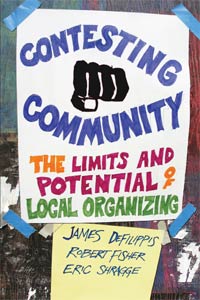Assertions regarding incorporating long-term vision and accepting conflict — as on-point as they may be — are easy to make; practicing it in our daily organizing lives is a tall order. The authors offer three examples of organizations that they believe are on the right track: ACORN (prior to its dissolution); the Immigrant Rights Centre in Montreal, Canada; and the Fifth Avenue Committee in Brooklyn. They make no claim that these groups have mastered the balance between being rooted in place and having an eye on a larger context. They do, however, argue that these three organizations have an “understanding of the changing political economy as establishing new barriers as well as providing opportunities to advance the causes of their organization” (p. 135). (See the authors’ Spring 2010 Shelterforce article, What Kind of Community Organizations and for What Purpose?.)
The groups highlighted do, in fact, exemplify the arguments of the book. However, the transformation of community organizing into a larger social movement often takes place through the collective action of a number of groups working in coalition. Two of the three groups chosen as exemplars are basically grounded in services or project development. Not included are examples from the many advocacy/organizing coalitions formed within the last 15 to 20 years for the sole purpose of advancing redistributive demands around issues of community-based development and growth. These coalition campaigns do not build projects or provide services; they concentrate solely on politics and policies — such as inclusionary zoning, community benefits agreements, and transit justice, among many. Further, many of these coalition campaigns combine economic and environmental justice demands, which ultimately require a direct look at systemic obstacles. Here, an exploration into examples such as the Clean Air and Ports Campaign, which originated in Los Angeles through LAANE (LA Alliance for a New Economy) and now has organizing efforts in five other cities, would be instructive. This effort consists of locally-based but nationally-connected campaigns that bring together a wide range of environmental justice and labor organizations (primarily the Teamsters, who have adopted a major organizing frame around environmental justice) with demands for good, green jobs and clean air. Other coalitions that we need to examine include the nascent Right to the City efforts, where local affordable housing advocates in eight metro areas connect with one another for mutual learning, framing, and organizing around housing, land use, and development. Certainly, project and service-oriented community groups form the troops of these coalitions, but the coalitions themselves are already acting on the ideas proposed by DeFilippis, Fisher, and Shragge.
The book concludes with a plea for a more straightforwardly radical understanding of how community organizing can relate to larger social movements, although their distinction between the two is drawn too narrowly, I think. My own research in Los Angeles on both economic and environmental justice organizers found that coalition leaders already consider themselves and their work to be part of ongoing social movements, even when this identification does not coincide with organizational affiliation. If the question is how, or if, these coalitions can play an important role in a larger social movement politics, the groundwork may already be laid.
Contesting Community calls for a “wider, larger-scale, and longer-term movement for social change” (p. 177). Community organizing as a process of movement-building is a process of learning in struggle. This book is a contribution to that learning.





Comments